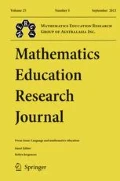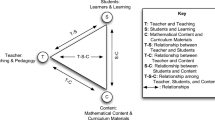Abstract
Structured problem-solving lessons are used to explore mathematical concepts such as pattern and relationships in early algebra, and regularly used in Japanese Lesson Study research lessons. However, enactment of structured problem-solving lessons which involves detailed planning, anticipation of student solutions and orchestration of whole-class discussion of solutions is an ongoing challenge for many teachers. Moreover, primary teachers have limited experience in teaching early algebra or mathematical reasoning actions such as generalising. In this study, the critical factors of enacting the structured problem-solving lessons used in Japanese Lesson Study to elicit and develop primary students’ capacity to generalise are explored. Teachers from three primary schools participated in two Japanese Lesson Study teams for this study. The lesson plans and video recordings of teaching and post-lesson discussion of the two research lessons along with students’ responses and learning are compared to identify critical factors. The anticipation of students’ reasoning together with preparation of supporting and challenging prompts was critical for scaffolding students’ capacity to grasp and communicate generality.










Similar content being viewed by others
Notes
Pseudonyms are used throughout for the names of the Lesson Study teams and students.
The teacher did not comment on the accuracy of this equation.
References
Anderson, N., Chapin, S., & O’Connor, C. (2011). Classroom discussions: seeing math discourse in action. Sausalito: Math Solutions.
Anthony, G., & Walshaw, M. (2007). Effective pedagogy in mathematics. Wellington: Ministry of Education.
Australian Curriculum and Assessment Authority (ACARA) (2012). Australian Curriculum: Mathematics. Retrieved from http://www.australiancurriculum.edu.au/Mathematics.
Becker, J. P., Silver, E. A., Kantowski, M. G., Travers, K. J., & Wilson, J. W. (1990). Some observations of mathematics teaching in Japanese elementary and junior high schools. The Arithmetic Teacher, 38(2), 12–21.
Bragg, L., Herbert, S., Loong, E., Vale, C. & Widjaja, W. (2016). Primary teachers notice the impact of language on children’s mathematical reasoning. Mathematics Education Research Journal, 28(4), 523–544.
Carpenter, T., Franke, M., & Levi, L. (2003). Thinking mathematically: integrating arithmetic and algebra in elementary school. Portsmouth: Heineman.
Carraher, D. W., Martinez, M. V., & Schliemann, A. D. (2008). Early algebra and mathematical generalization. ZDM — The International Journal on Mathematics Education, 40(1), 3–22.
Clarke, D. M., Clarke, D. J., & Sullivan, P. (2012). Reasoning in the Australian Curriculum: understanding its meaning and using the relevant language. Australian Primary Mathematics Classroom, 17(3), 28–32.
Clarke, D.J., Roche, A., Cheeseman, J. & Sullivan, P. (2014). Encouraging students to persist when working on challenging problems. The Australian Mathematics Teacher, 70(1), 3–11.
Cooper, T., & Warren, E. (2008). The effect of different representations on Years 3 to 5 students’ ability to generalise. ZDM — The International Journal on Mathematics Education, 40(1), 23–37.
Department of Education and Early Childhood Development (DEECD) (2012). Principles of Teaching and Learning P-12 Unpacked. Retrieved from http://www.education.vic.gov.au/school/teachers/support/Pages/unpacked12.aspx.
Ernest, P. (1989). The knowledge beliefs and attitudes of a mathematics teacher: a model. Journal of Education for Teaching, 15(1), 13–33.
Fraivillig, J. (2001). Strategies for advancing children’s mathematical thinking. Teaching Children Mathematics, April, 2001, 452–459.
Fujii, T., & Stephens, M. (2001). Fostering understanding of algebraic generalisation through numerical expressions: The role of the quasi-variables. In H. Chick, K. Stacey, J. Vincent, & J. Vincent (Eds.), The future of the teaching and learning of algebra. Proceedings of the 12th ICMI study conference (Vol. 1, pp. 258–264). Australia: Melbourne.
Healy, L., & Hoyles, C. (1999). Visual and symbolic reasoning in mathematics: making connections with computers? Mathematical Thinking and Learning, 1(1), 59–84.
Inoue, N. (2010). Zen and the art of neriage: facilitating consensus building in mathematics inquiry lessons through lesson study. Journal of Mathematics Teacher Education, 14(1), 5–23.
Irwin, K., & Britt, M. (2005). The algebraic nature of students’ numerical manipulation in the New Zealand Numeracy Project. Educational Studies in Mathematics 58, 169–188.
Kaput, J. (1999). Teaching and learning a new algebra. In T. Romberg & E. Fennema (Eds.), Mathematics classroom that promotes understanding (pp. 133–155). Hillsdale: Lawrence Erlbaum.
Lannin, J., Barker, D., & Townsend, B. (2006). Algebraic generalisation strategies: factors influencing student strategy selection. Mathematics Education Research Journal, 18(3), 3–28.
Lobato, J., Hohensee, C., & Rhodehamel, B. (2013). Students’ mathematical noticing. Journal for Research in Mathematics Education, 44(5), 809–850.
Loong, E., Vale, C., Herbert, S., Bragg, L. & Widjaja, W. (2017). Tracking change in primary teachers’ understanding of mathematical reasoning through demonstration lessons. Mathematics Teacher Education and Development, 19(1), 5–29.
Mason, J. (2010). Attention and intention in learning about teaching through teaching. In R. Leikin & R. Zazkis (Eds.), Learning through teaching mathematics: development of teachers’ knowledge and expertise in practice (Vol. 5, pp. 23–47). New York: Springer.
Mason, J., Stephens, M., & Watson, A. (2009). Appreciating mathematical structure for all. Mathematics Education Research Journal, 21(2), 10–32.
Mulligan, J., & Mitchelmore, M. (2009). Awareness of pattern and structure in early mathematical development. Mathematics Education Research Journal, 21(2), 33–49.
Papic, M., & Mulligan, J. (2007). The growth of early mathematical patterning: an intervention study. In J. Watson & K. Beswick (Eds.), Mathematics: Essential Research, Essential Practice Proceedings of the 30th annual conference of the Mathematics Education Research Group of Australasia, Melbourne (pp. 591–600). Hobart: MERGA.
Radford, L. (2000). Signs and meanings in students’ emergent algebraic thinking: a semiotic analysis. Educational Studies in Mathematics, 42(3), 237–268.
Radford, L. (2008). Iconicity and contraction: a semiotic investigation of forms of algebraic generalizations of patterns in different contexts. ZDM, 40(1), 83–96.
Radford, L. (2012). Early algebraic thinking: Epistemological, semiotic, and developmental issues. Regular lecture presented at the 12th International Congress on Mathematical Education 8 July – 15 July, 2012, Seoul, Korea. Available from http://www.icme12.org/sub/sub02_04.asp.
Rivera, F. D., & Rossi Becker, J. (2008). Middle school children’s cognitive perceptions of constructive and deconstructive generalizations involving linear figural patterns. ZDM Mathematics Education, 40, 65–82.
Shimizu, Y. (1999). Aspects of mathematical teacher education in Japan: focusing on the teachers’ roles. Journal of Mathematics Teacher Education, 2(1), 107–116.
Stein, M., Engle, R., Smith, M., & Hughes, E. (2008). Orchestrating productive mathematical discussions: five practices for helping teachers move beyond show and tell. Thinking and Learning, 10(4), 313–340.
Stephens, M., & Armanto, D. (2010). How to build powerful learning trajectories for relational thinking in the primary school years. In L. Sparrow, B. Kissane, & C. Hurst (Eds.), Shaping the future of mathematics education: Proceedings of the 33rd annual conference of the Mathematics Education Research Group of Australasia (pp. 523–530). Fremantle: MERGA.
Stigler, J. W., Gonzalez, P., Kawanaka, T., Knoll, S., & Serrano, A. (1999). The TIMSS videotape classroom study: Methods and findings from an explanatory research project on eighth-grade mathematics instruction in Germany, Japan and the United States. Washington, DC: US Government Printing Office.
Stylianides, G. (2010). Engaging secondary students in reasoning and proving. Mathematics Teaching, 219, 39–44.
Sullivan, P., Mousley, J., & Zevenbergen, R. (2006). Teacher actions to maximize mathematics learning opportunities in heterogeneous classrooms. International Journal of Science and Mathematics Education, 4(1), 117–143.
Sullivan, P., Walker, N., Borcek, C., & Rennie, M. (2015). Exploring a structure for mathematics lessons that foster problem solving and reasoning. In M. Marshman, V. Geiger, & A. Bennison (Eds.), Mathematics education in the margins Proceedings of the 38th annual conference of MERGA (pp. 41–56). Sunshine Coast: MERGA.
Takahashi, A. (2008). Beyond show and tell: Neriage for Teaching through problem-solving (Ideas from Japanese problem-solving approaches for teaching mathematics). Paper presented at the 11th International Congress on Mathematics Education, Monterey, Mexico July 6–13, 2008.
Van Zoest, L. R., Jones, G. A., & Thornton, C. A. (1994). Beliefs about mathematics teaching held by pre-service teachers involved in a first grade mentorship program. Mathematics Education Research Journal, 6(1), 37–55.
Warren, E., & Cooper, T. (2005). Introducing functional thinking in Year 2: a case study of early algebra teaching. Contemporary Issues in Early Childhood, 6(2), 150–162.
Warren, E., & Miller, J. (2013). Young indigenous students’ effective engagement in mathematics: the role of language, patterns, and structure. Mathematics Education Research Journal, 25(1), 151–171.
Widjaja, W., Vale, C., Groves, S. & Doig, B. (2015). Teachers’ professional growth through engagement in lesson study. Journal of Mathematics Teacher Education online, 20(4), 357–383.
Yeap, B., & Kaur, B. (2008). Elementary school students engaging in making generalisation: a glimpse from a Singapore classroom. ZDM, 40(1), 55–64.
Acknowledgements
The project team gratefully acknowledges the contributions of participating teachers, coaches, students, and schools and Max Stephens, who provided the “outside expert commentary” in the post-lesson discussions of the research lessons discussed in this article.
Funding
The Implementing structured problem-solving mathematics lessons through Lesson Study project was funded by the research centre at authors’ university.
Author information
Authors and Affiliations
Corresponding author
Rights and permissions
About this article
Cite this article
Vale, C., Widjaja, W., Doig, B. et al. Anticipating students’ reasoning and planning prompts in structured problem-solving lessons. Math Ed Res J 31, 1–25 (2019). https://doi.org/10.1007/s13394-018-0239-5
Received:
Revised:
Accepted:
Published:
Issue Date:
DOI: https://doi.org/10.1007/s13394-018-0239-5




